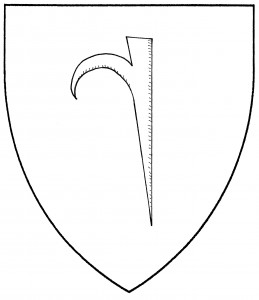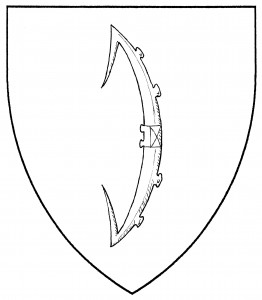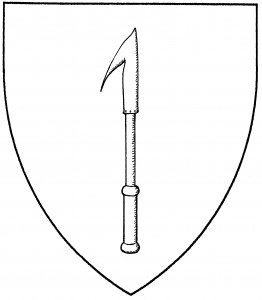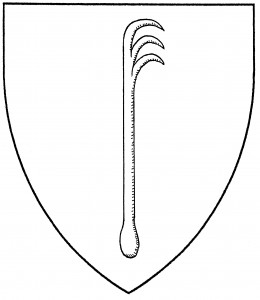A hook is a curved or barbed implement, usually of metal, used for holding onto something, and thus to catch, pull, or suspend it. There are several specific types of hook in period heraldry, of which the fishhook is probably the most common. Other types of hook are named according to their use.
The “tenterhook” is used to fasten cloth to a frame (called a “tenter”) for stretching or drying. It’s a period charge, found in the arms of Clerk or Clerkes, c.1480 [DBA4 172]; the form shown here is taken from Parker [331]. Period armory also has examples of the “havette” or “habick”, which performed the same function as the tenterhook; it’s found in the arms of Worshipful Company of Shearmen, 1510 (later incorporated into the Clothworkers, 1530) [Bromley & Child 48].
We also have period examples of the “hayhook”, for handling hay bales, in the canting arms (German Heu, “hay”) of von Hödorff or von Heudorff, c.1450 [Ingeram 120, Scheibler 82]; its handle is to base by default. there is also the “meat hook”, for hanging meat, in the arms of da Peroxa, mid-15th C. [Triv 282].
Society armory gives us the “flesh hook”, a cooking tool used to take large portions of meat from the pot. It’s a period artifact, as seen in the Luttrell Psalter c.1340, but as of this writing we have no confirmed examples of its use in period armory. The flesh hook has its handle to base by Society default.
For related charges, see anchor, grappling iron. See also crampon, fork, staple.
Joleicia of Litchfield bears: Or, a bend raguly vert between two tenterhooks sable.
Milda de Hay bears: Quarterly azure and vert, two hayhooks in saltire Or.
Huon Damebrigge bears as a badge: In saltire a flesh hook and a strainer sable.



